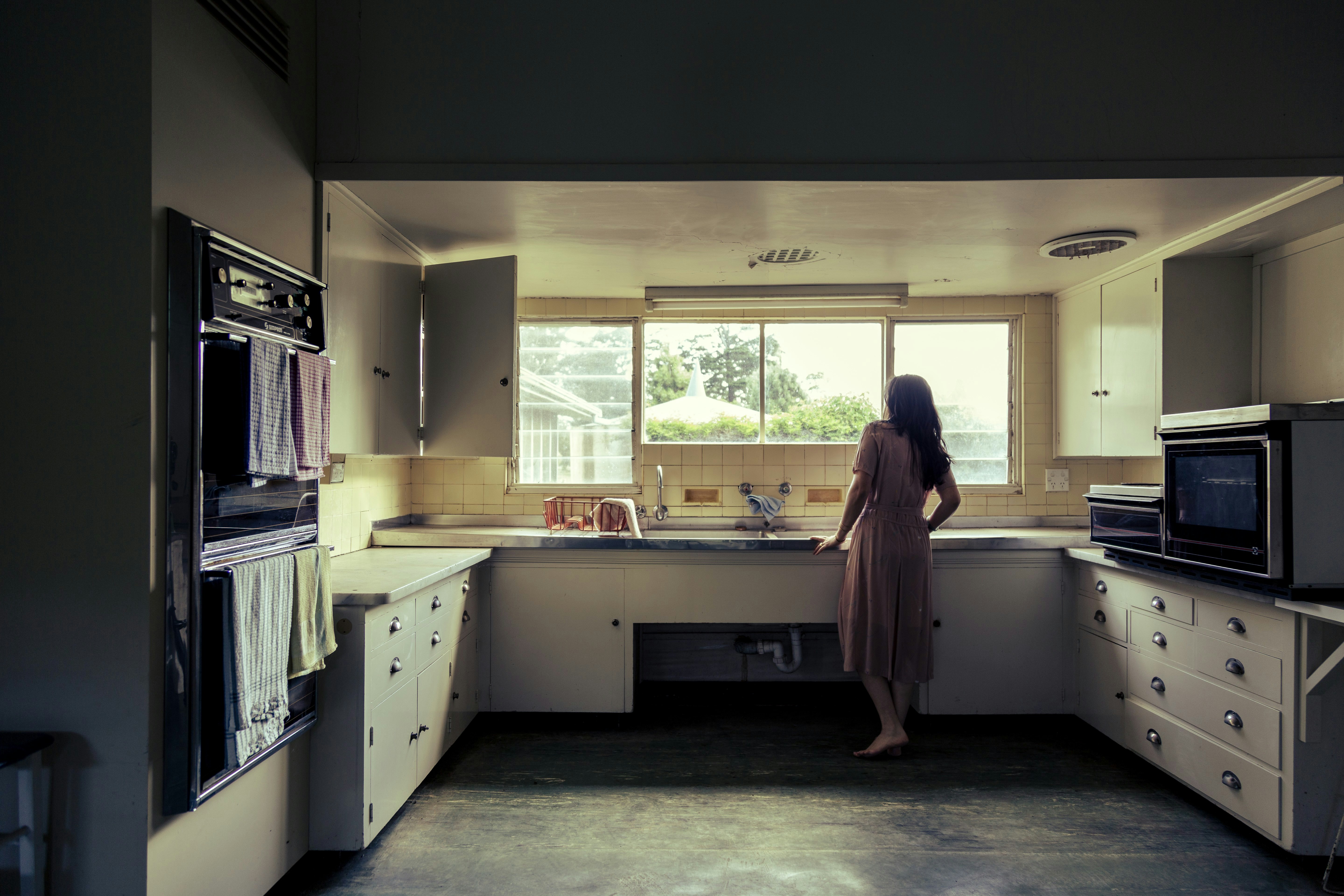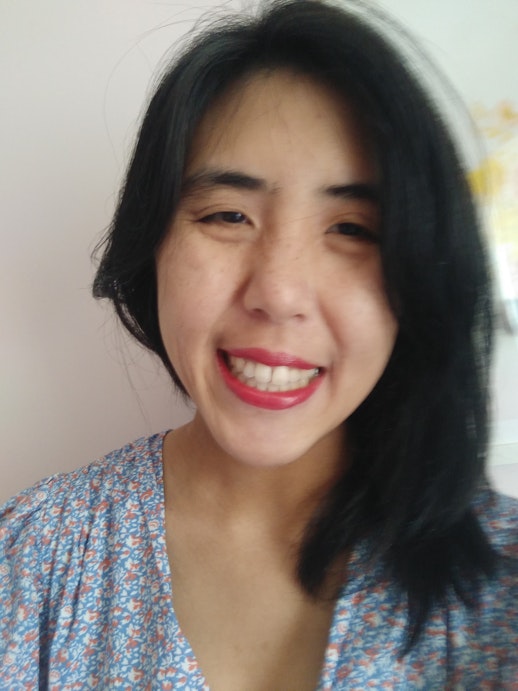Shades of Longing
Shu-Ling Chua

Longing, we say, because desire is full / of endless distances.
—Robert Hass, ‘Meditation at Lagunitas’
In August, I visited ACMI’s exhibition Light alone.
I was drawn to Liliane Lijn’s moving sculpture, Liquid Reflections (1968)—the dance between the two orbs on a rotating disc, their shadows on the wall, the gentle clack they made on contact. The small gesture made me think of you, how you had come into my life, then bounced to the other side of the world.
I was also drawn to Vilhelm Hammershøi’s painting, Interior (1899), of his wife Ida from behind, the edge of her apron just visible. Two white doors, shut, grant her privacy and possibility. She is lost in her own world.
I didn’t feel sad or lonely at the exhibition but afterwards, eating alone at Don Don, I cried.
*
Pia Johnson’s exhibition Faint Echoes, which I visited a week later, is similarly filled with faceless women.
In A Kitchen Poem (2020), Johnson peers out the window, one hand on the edge of the sink, one foot delicately arched, as if about to push off. The kitchen is empty yet comforting. Checkered dish cloths hang over the oven. At its centre, a pale blue dish cloth rests upon the tap, shell-like. A cupboard door swings open.
To its left, in Holding Still (2020), Johnson stands before a wall of glass, facing a lush garden and technicolour pool. Loose hair tumbles down her back and her arms are relaxed. The artist leans forward on the balls of her feet, giving the image an air of expectancy. The light is harsh, oppressive even. The contrast between a bright exterior and shadowy, cool interior is a striking reminder of the shiny façade we present to the world.
(If you and I had gone on a ‘conventional’ first date,1 we would’ve likely held back or tried to impress. Instead, because we had no knowledge, or expectations, of one another, we were completely open. What was supposed to be a holiday fling quickly became serious. You were leaving in two weeks. There was no time.)
Johnson’s works remind of Hammershøi’s but hers feel more active. That raised foot.
I see myself in the empty rooms, in these faceless women. All these years later, I’m still a lone figure pausing in front of a painting. I’m still crying because I miss someone.
*
Weeks later, I visited a dear friend, who is a grandmother figure to me, for afternoon tea.
We discussed our favourite pieces at ACMI and agreed that visiting galleries alone can be freeing.
*
I send you a 17-second video of Liquid Reflections:
This was my fav! I love the colours, shadow, movement and gentle clack the orbs make when they meet / dance (10sec)
You reply that it seems I had a wonderful day. I did but I still missed you.
I send you Hammershøi’s paintings.
You reply that they’re beautiful, like someone you know, and that they can go along with my window essay.
For two years, I’ve been writing an essay on windows as a symbol of longing. It takes Andrew Wyeth’s painting Wind from the Sea (1947), Wong Kar Wai’s film In the Mood for Love and conversations with strangers in New York City as starting points to explore loneliness, self-concealment and female interiority.
The image of the ingenue—framed in her upstairs window or leaning against a balcony—is a universal symbol of longing. From Shakespeare’s Juliet to Eileen Chang’s naïve schoolgirl Ge Weilong, from Britney’s ‘Lucky’ to Sunmi’s ‘보라빛 밤 (pporappippam)’, she looks out as we look in. We are all her.
I thought the essay was about longing but now I think it’s about restlessness and creativity.
*
To be in a long-distance relationship is
to be constantly yearning.
We leave something in a room for each other to find.
*
For six months, we’ve been messaging every day and video-calling weekly.
I come to expect your morning messages around the time I finish work. I wish you good night even though it’s afternoon in London. I message you during my morning commute, before you sleep.
We send selfies (before you dated me, you didn’t take selfies). We send cute-silly videos of dogs and couples. You begin to also end your messages with x. I adopt your cheeky ‘And?’ and you my indignant ‘Excuse me’.

In May, you send a clip of a young woman who wants to sit next to her boyfriend.
You’re so funny. I think you’re the first girl that I’ve dated that would rather sit next to me than across me x
I like both! But I’m prob also the first girl to date you *knowing* you’re leaving in a couple of wks x
So must maximise time near husband
In July, I send an illustration of a baby chick and a baby penguin sheltering beneath a leaf umbrella.
Which one is you and which one is me?
I think.. because husband is stressed atm, I’m penguin.
We’ll take it in turns to be penguin and chick x
Months later, when I’m feeling down, I send a screenshot of our exchange.
Now husband is penguin and wife is chick x
*
In Liu Ziqian’s self-portraits, the artist is often obscured behind a screen, or part of her body is revealed in a mirror. Only her hand is visible, reaching towards an iris in the foreground. An arm arches from a vase, mimicking a pale pink rose. A hand reaches towards its mirror image. Tulips cradle Liu’s spine and shoulder.
Liu hopes to create a small world in her works, a space which belongs to the artist and the viewer, as it has become very rare to have the opportunity to be alone. The self-portrait is a way to communicate with herself. “I feel most free when I’m alone,” she says. “A lot of people think of loneliness when they think of being alone, but I think loneliness is sometimes used for enjoyment, to enjoy solitude is to discover beauty.”
Private spaces are vital to artists, particularly women artists who are still expected to juggle art-making with care-giving. Art takes root in dreaming.
You and I are comfortable with solitude, travelling alone and sitting at a pub/bar with a book.
We are also both artists: an architect and a writer.
Once, I sent you empty interior photos of an old Danish mansion. You wondered how the space would feel in real life, whereas I was content to take pleasure in the images. Space, I suspect, is more visceral for you.
A writer translates the physical into the imaginable; an architect does the reverse.
When I mention this essay I’m writing about intimacy, you tell me about the time you bumped into a couple (both were also your friends and colleagues) at a café. They were reading separately, not talking, just enjoying each other’s company. You said that it was so intimate.
I tell my friend J about your sweet anecdote. “That’s intimacy!” she says. “He wants to be part of your process.”
“Yes, and me telling you this story is intimacy too!”
We burst into laughter.
Layers of intimacy upon intimacy.
*
things more intimate than sex
seeing D, at the first public event I’d been to in a year, take their mask off to sip water
the groan-shudder of the central heating, just before it kicks in
splitting a pastry with you on a street bench, as the world passes by on a Saturday morning
resting my head on my mother’s knee as she puts eyedrops in my eyes
talking with G in her car as a full moon rises over the train station, saying goodbye twice, thrice
*
The empty rooms and faceless women of Johnson’s, Hammershøi’s and Liu’s works remind me that there is intimacy in being alone: intimacy despite distance, as well as intimacy in distance.
Once, I tried to brush a hair from your cheek, forgetting the glass screen between us.
Another time you endearingly held my selfie close to your face, as I laughed and took a photo of you.
You make me happy
Each time we talk on the weekend I feels we are on our own world x
I just wanted you to know this x
Wife is happy crying x
I love that we are creating our own world and secret language
Being with you feels like home
In ‘Blue’, a 2017 essay on distance and the art of Agnes Martin, Larissa Pham writes, ‘The space between staying and leaving, I think, is called longing.’
There are shades of longing too, no?
To be intimate is to be physically close, to let someone in, to be vulnerable, open, transparent and honest.
To be intimate is also to trust, to accept the endless distances of desire, to lead shared but separate lives.
Both can be true.
Notes
Endnote:
1. The night we met, you asked if you could take me back to London. I was touched and joked that we could get married at your friends’ wedding the next day. When I got home, I texted: Thanks for a great first date/honeymoon husband. You replied at the same moment with a screenshot of my number saved as: Shu-Ling #wife.
Image captions (top-bottom):
1. Pia Johnson, A Kitchen Poem, from Mooramong Green series 2020, Archival inkjet print.
2. Pia Johnson, Holding Still, from Mooramong Green series 2020, Archival inkjet print.
About the contributor
Shu-Ling Chua is an essayist and author of the award-winning essay collection Echoes (2020).
